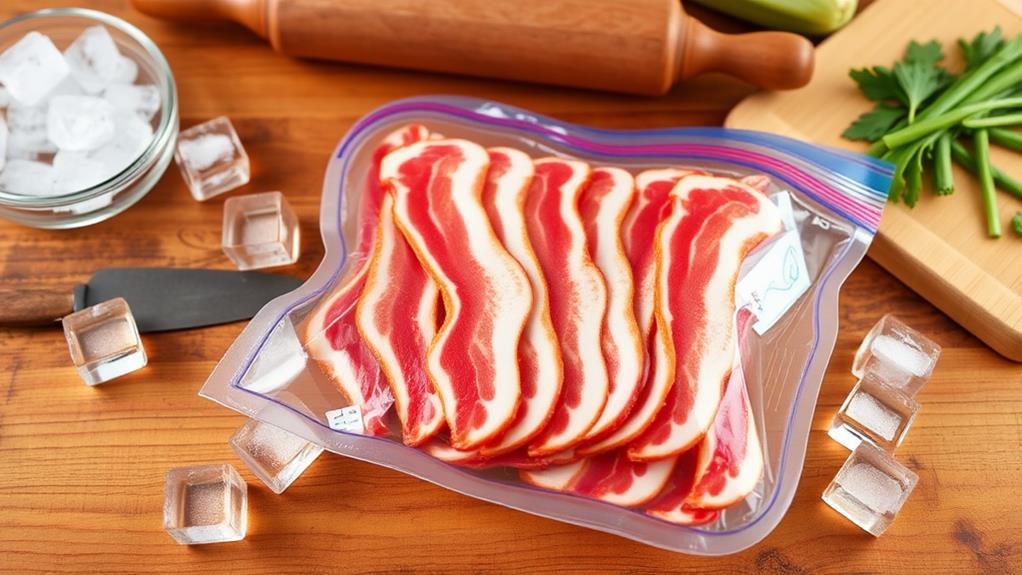Freezing bacon is a great way to save money and reduce waste. Start by laying your raw bacon on a lined baking sheet and freezing it for a few hours until solid. Once frozen, transfer the slices to freezer-safe bags, removing excess air to prevent freezer burn. You can also separate slices with parchment paper for quick meals later. When you're ready to use it, thaw bacon in the refrigerator, or use the cold water method for quicker results. This handy technique not only keeps your bacon fresh but also opens up plenty of delicious meal options. Keep exploring for more tips!
Benefits of Freezing Bacon
Freezing bacon offers numerous advantages that can enhance your cooking experience. First, it notably extends the shelf life of your bacon, preserving its quality for 3-6 months. This means you can enjoy that whole pound of bacon without worrying about spoilage, helping you reduce waste.
By portioning your bacon before freezing, you can easily control your servings and only use what you need for each recipe. This way, you minimize excess leftovers that might otherwise go to waste. Additionally, maximizing savings online by purchasing bacon during sales can lead to even greater cost effectiveness, allowing you to stock up without overspending.
Another great benefit is the cost savings. Purchasing bacon in bulk when it's on sale and then freezing it allows you to stock up without breaking the bank. You'll find that buying larger quantities can lead to notable savings over time.
Properly freezing bacon also prevents freezer burn, ensuring the flavor and texture are maintained when you thaw it for future meals. Plus, having frozen bacon on hand provides you with meal flexibility. You can incorporate thawed bacon into various dishes, adding delicious flavor and protein without the hassle of frequent grocery trips.
Necessary Supplies for Freezing
To successfully freeze bacon, you'll need a few essential supplies to make the process smooth and efficient. First, gather thawed, raw bacon and a baking sheet lined with parchment paper. This will help with easy handling and cleanup as you prepare your bacon for freezing.
Consider utilizing expense management apps that offer receipt scanning features to help maintain your food budget and track grocery expenses effectively.
Next, consider using freezer bags or airtight freezer-safe containers to store your frozen bacon. These options will prevent freezer burn and maintain the quality of your bacon over time. If you're freezing cooked bacon, layer the slices with wax paper or parchment paper to allow for easy separation later.
Don't forget labels! They're vital for identifying contents and dates, so you know how long your frozen bacon has been stored. When you're ready to pack your bacon, a ziplock freezer bag can be a great choice. It allows you to remove excess air before sealing, which helps preserve the bacon's freshness during storage.
With these supplies in hand, you're well on your way to effectively freezing bacon and saving money while reducing waste.
Step-by-Step Freezing Process
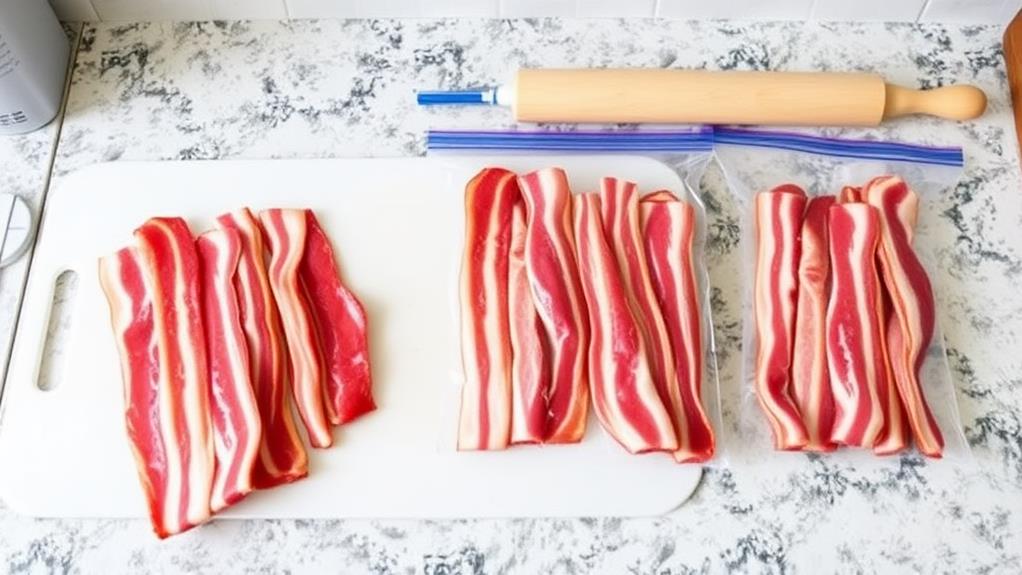
When you're ready to freeze bacon, starting with a lined baking sheet makes the process easier and more efficient. First, grab a baking sheet and line it with parchment paper to prevent the bacon from sticking during the freezing process.
This method not only preserves the quality of your bacon but can also enhance your overall cooking experience, as it helps reduce waste and save money, similar to the benefits of using exclusive digital coupons for electronics.
Next, open the package of thawed, raw bacon and roll each slice into a spiral shape. Place them upright on the parchment-lined baking sheet, making sure to leave space between each roll.
Freeze the bacon on the baking sheet for at least 4 hours or overnight until the slices are solid. This step guarantees that the slices don't stick together, making it easier to grab just what you need later.
Once the bacon is frozen, transfer the rolled slices to a freezer-safe bag or container. Be sure to remove as much air as possible to prevent freezer burn, which can ruin your delicious frozen bacon.
Thawing Frozen Bacon
When it's time to enjoy your frozen bacon, you've got a few safe thawing methods to choose from.
The refrigerator method is the best for gradual defrosting, allowing for more even thawing and maintaining flavor.
However, you can also use cold water or the microwave for quicker options, which can be helpful when you're short on time.
Just remember to cook the bacon right after thawing to keep it safe and delicious!
streamlined financial management guarantees you can plan your meals without the worry of waste.
Safe Thawing Methods
Thawing frozen bacon requires careful attention to safety to prevent bacterial growth. The safest method to thaw bacon is to place it in the refrigerator overnight. This allows it to defrost gradually and safely at a controlled temperature.
If you need to thaw bacon more quickly, you can submerge the sealed package in cold water for about 30 minutes. Just remember to refresh the water if it starts to warm up.
You can also use a microwave on the defrost setting for 20-30 seconds, but make certain to cook the bacon immediately afterward to avoid harmful bacteria from developing.
It's essential to steer clear of thawing bacon at room temperature, as this can encourage the growth of those harmful bacteria on the surface.
While cooking bacon directly from frozen is an option, you'll need to increase the cooking time and guarantee the strips separate in the pan for even cooking.
Cooking After Thawing
After you've safely thawed your bacon, cooking it's a straightforward process that lets you enjoy its delicious flavor and crisp texture.
You've got a couple of options for cooking thawed bacon. You can add the slices of bacon directly to a preheated skillet. As they cook, separate the strips to guarantee even cooking and crispiness.
Alternatively, you can bake it in the oven for an easy, hands-off approach. Just lay the bacon on a baking sheet and pop it in at 400°F until it reaches your desired crispness.
Whichever method you choose, make certain to cook the thawed bacon immediately after thawing. Avoid refreezing it to maintain quality and safety.
Cooking thawed bacon right away also helps you save money by reducing waste. Whether you're whipping up a breakfast feast or adding a savory touch to your favorite dish, the rich flavor of cooked bacon is hard to resist.
Utilizing Leftover Bacon
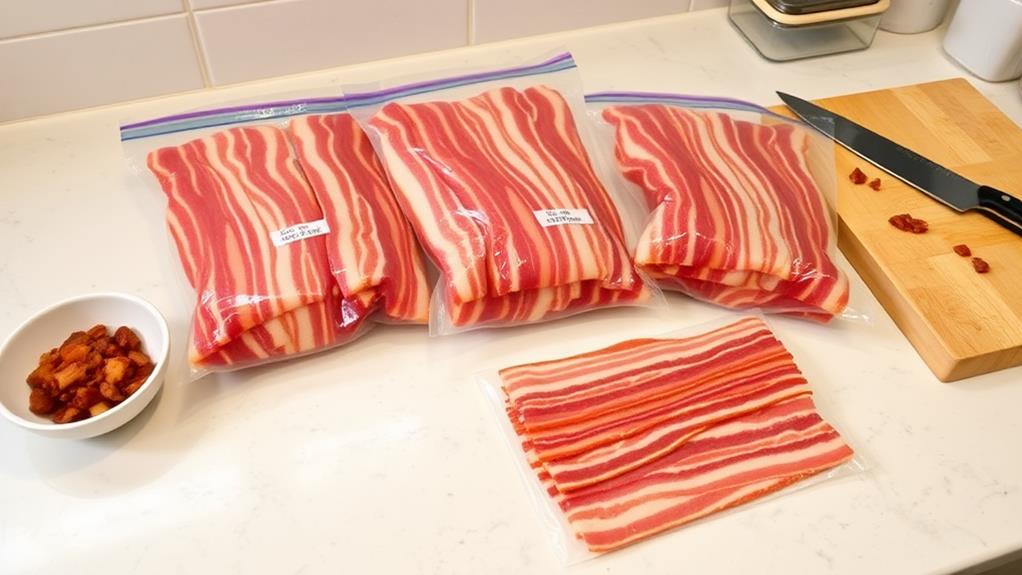
You can turn leftover bacon into something delicious with just a bit of creativity.
By utilizing AI-driven tools that suggest complementary products, you can easily find great recipes that incorporate bacon into various dishes.
Whether it's tossing uncooked bacon into a hearty soup or crumbling cooked bacon over a fresh salad, there are plenty of ways to make the most of what you have.
Repurposing Unused Bacon
Leftover bacon can be a culinary treasure, offering endless possibilities for delicious dishes. When you're repurposing unused bacon, you not only create flavorful meals but also help reduce waste.
If you've got uncooked leftovers, try dicing them and adding them to soups, stews, or casseroles. This enhances the flavor while packing in extra protein.
For cooked leftover bacon, consider chopping it up to use as a topping for salads, baked potatoes, or pasta dishes. It adds a savory crunch and depth that elevates any meal.
Breakfast lovers can incorporate bacon into omelets or quiches, turning those remnants into hearty, flavorful options.
You can also get creative by making bacon-wrapped vegetables or stuffed mushrooms, maximizing your resources while showcasing that leftover bacon.
Don't forget about bacon grease! Saving it from cooking allows you to infuse flavor into other dishes, such as cornbread, sautéed vegetables, or frying eggs.
Creative Leftover Ideas
Repurposing unused bacon opens up a world of creative culinary opportunities. You can easily use leftover bacon to enhance many dishes, making the most of what you have. For a savory crunch, chop up that leftover bacon and toss it into your salads. It'll elevate the flavor profile and make your greens more delicious.
If you've got some uncooked leftover bacon, consider incorporating it into soups or stews. It adds depth and richness, turning simple recipes into hearty meals. You can also mix chopped bacon into pasta dishes for that delightful smoky taste, making it a versatile ingredient across cuisines.
Don't forget about the bacon grease! Use it for cooking to impart flavor into recipes like cornbread or sautéed vegetables, maximizing your resources and minimizing waste.
And when it comes to breakfast, repurpose leftover bacon in breakfast sandwiches or burritos. Not only does this guarantee no edible parts go to waste, but it also contributes to sustainability and mindful consumption.
With just a bit of creativity, your leftover bacon can transform meals and reduce waste. So, get cooking!
Cooking Methods for Bacon
When it comes to cooking bacon, several methods can elevate your breakfast or any dish that calls for this savory delight. One popular technique is baking raw bacon in the oven at 400 degrees Fahrenheit. This method allows for even cooking and minimizes mess, accommodating two baking sheets at once for batch preparation.
By utilizing digital coupons for your grocery shopping, you can save considerably on bacon and other essentials. If you want crispier bacon that's a bit healthier, consider using a broiler pan to let the grease drip away.
Stovetop frying is another option that delivers quick results, but it requires your attention to avoid splatters and uneven cooking. A splatter guard can make cleanup easier.
Alternatively, air frying bacon can achieve a crispy texture with less grease, cooking faster than traditional frying methods.
For a unique flavor twist, grilling bacon can enhance its taste profile while adding a smoky element that complements various dishes.
Whichever cooking method you choose, you'll enjoy delicious bacon that can elevate any meal. Don't forget, if you've got extra bacon, freezer cooking helps preserve it for future use!
Storage Solutions for Bacon
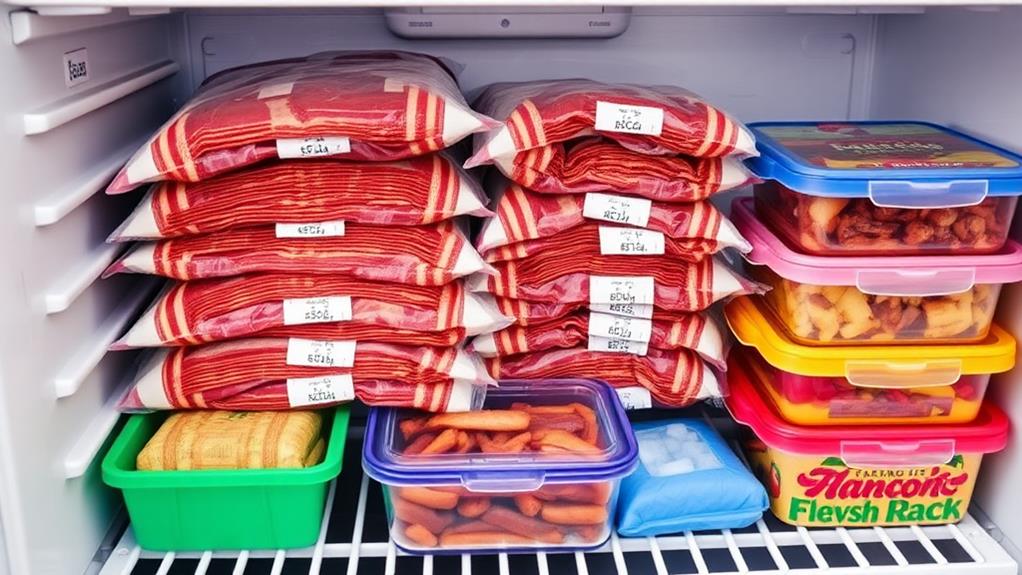
Properly storing bacon is essential to maintaining its freshness and flavor, and there are several effective methods to contemplate. First, always store raw bacon at the bottom of your fridge in a sealed container. This prevents contamination and keeps it fresher for longer.
When you're ready to freeze, use freezer bags or airtight containers, making sure to remove as much air as possible to avoid freezer burn. For added efficiency, consider utilizing expense tracking tools to manage your food budget while minimizing waste.
To make cooking easier later, consider separating bacon slices with greaseproof paper before freezing. This allows for quick defrosting and portion control. Don't forget to label storage containers with the date and quantity of bacon. This helps you track usage and prevents spoilage.
Here are some tips to make your bacon storage experience enjoyable:
- Enjoy the convenience of grabbing just what you need.
- Feel satisfied knowing you're minimizing waste.
- Relish in the delicious flavor of perfectly preserved bacon.
Additionally, consider using the accordion method with saran wrap or butcher paper. This technique saves space in your freezer and keeps your bacon organized.
With these storage solutions, you'll always have fresh bacon on hand!
Meal Ideas With Bacon
There's no denying that bacon adds an irresistible flavor to a variety of meals. Start your day right with the classic pair of bacon and eggs. You can scramble them together or whip up a hearty breakfast burrito packed with delicious bacon and your favorite fillings.
For a twist, try a frittata that includes crumbled bacon for extra richness. Incorporating crispy bacon bits can also enhance your meal experience, similar to how automated investment management tools help streamline your financial goals.
Bacon also shines in salads. Toss crispy bacon bits into a classic Caesar or a fresh spinach salad to bring a savory crunch that elevates the dish.
If you're craving pasta, consider preparing carbonara or mac and cheese, where the smoky flavor of cooked bacon complements the creamy sauce beautifully.
Don't forget about baked potatoes! Load them up with crispy bacon for an indulgent topping that adds texture and flavor.
You can even chop up some bacon and fold it into savory muffins or cornbread, enhancing these baked goods with a delightful smoky taste.
Additional Tips and Considerations
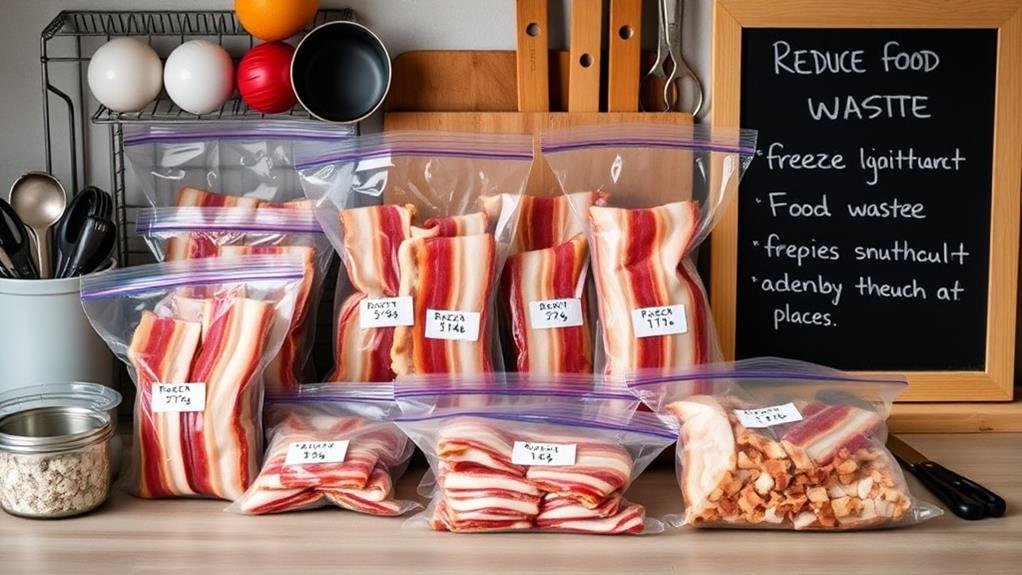
To make the most of your bacon storage, consider a few key tips that enhance both convenience and flavor. By implementing these strategies, you can enjoy your bacon while minimizing waste and maximizing savings.
- Monitor prices and buy in bulk during sales to save money and reduce shopping trips.
- Freeze bacon in small amounts, like two slices per package, to master portion control and simplify meal prep.
- Store bacon grease in a separate container after cooking; it's a fantastic flavor booster for future meals.
Additionally, don't forget about labeling bags with freezing dates. This simple step guarantees you use older packages first, maintaining quality and preventing spoilage.
Engaging in freezer cooking can also be a game changer; prepare meals that incorporate bacon ahead of time, so you always have quick, delicious options ready to go.
Conclusion
Freezing bacon not only saves you money but also cuts down on waste, making it a smart choice for any kitchen. By taking a few moments to prep and store your bacon properly, you can enjoy its deliciousness whenever you crave it. Think of it like hitting the pause button on a favorite song—you can savor it later without losing any of its flavor. So, grab your supplies and start freezing; your future self will thank you!

